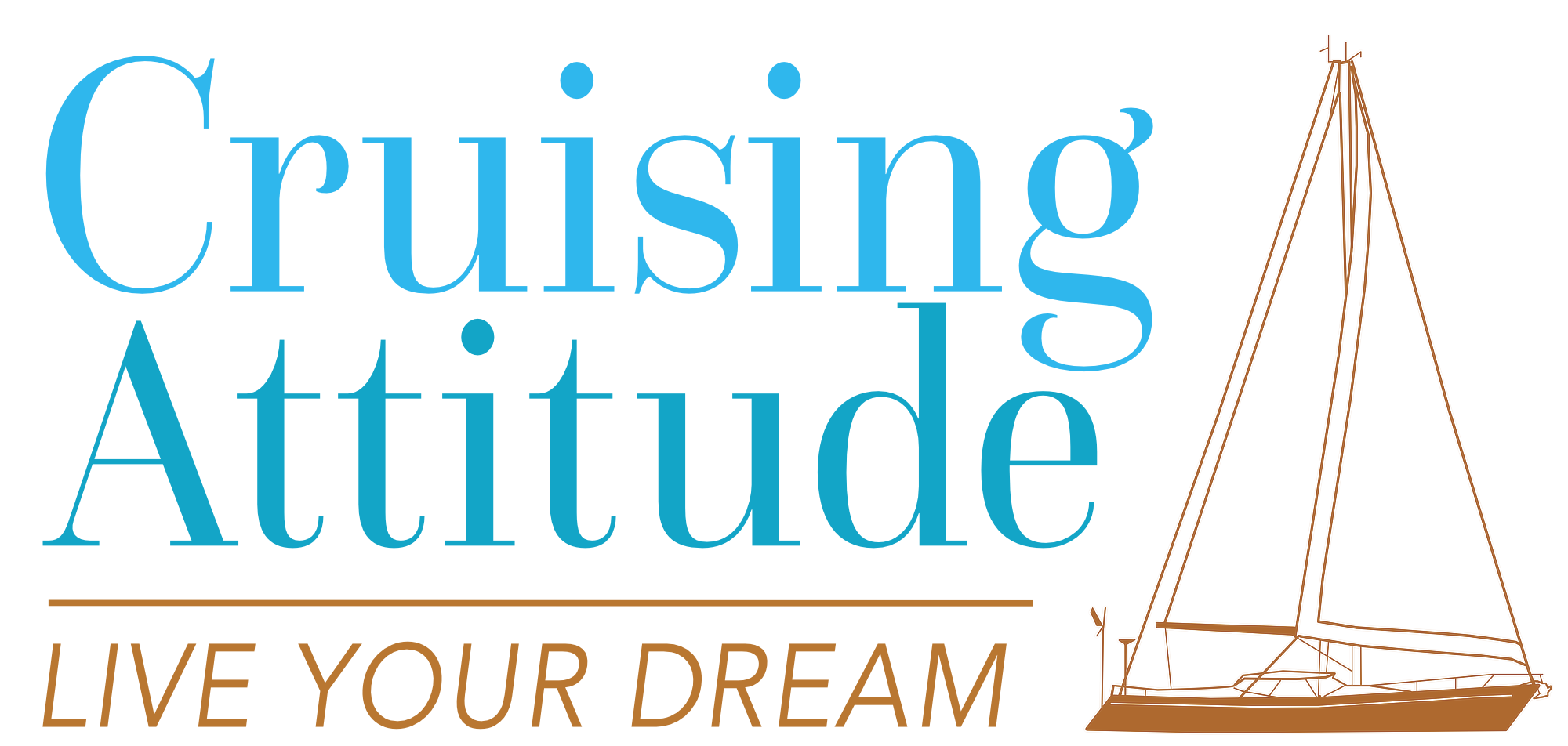 Is this our future boat? We arrived at the Discovery yard full of anticipation, like children visiting Disneyworld for the first time. I had a feeling in my heart that this was to be “the boat”. But we wanted to have that feeling in our brains as well as our hearts – that the emotional side would agree with the logical, analytical side. Sometimes, as you know, these two sides don’t always agree.
Is this our future boat? We arrived at the Discovery yard full of anticipation, like children visiting Disneyworld for the first time. I had a feeling in my heart that this was to be “the boat”. But we wanted to have that feeling in our brains as well as our hearts – that the emotional side would agree with the logical, analytical side. Sometimes, as you know, these two sides don’t always agree.
We were greeted on Monday morning by Mark Williams, Discovery’s sales director, and were ushered into the conference room. After tea and shortbread (so English!), we were taken to see the yachts in build. There were two 57s and two 55s.
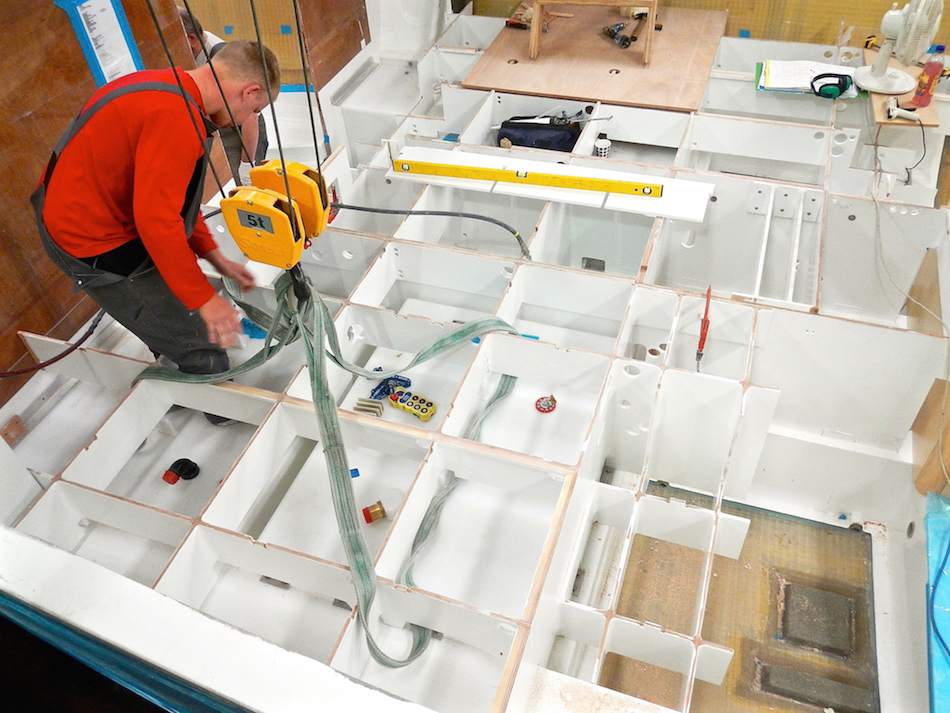
Early stages of construction in a Discovery 57
Seeing boats in their various stages of build enabled us to see the quality of materials used underneath the floors and behind the bulkheads and ceilings, something you don’t see in photos or at boat shows. Since Discoveries are constructed with the hull in an open state (the deck and cabin top are attached later in the build) we were really able to see everything. It was both fascinating and enlightening – something I’d never seen before, as my previous boats were bought as “previously owned”.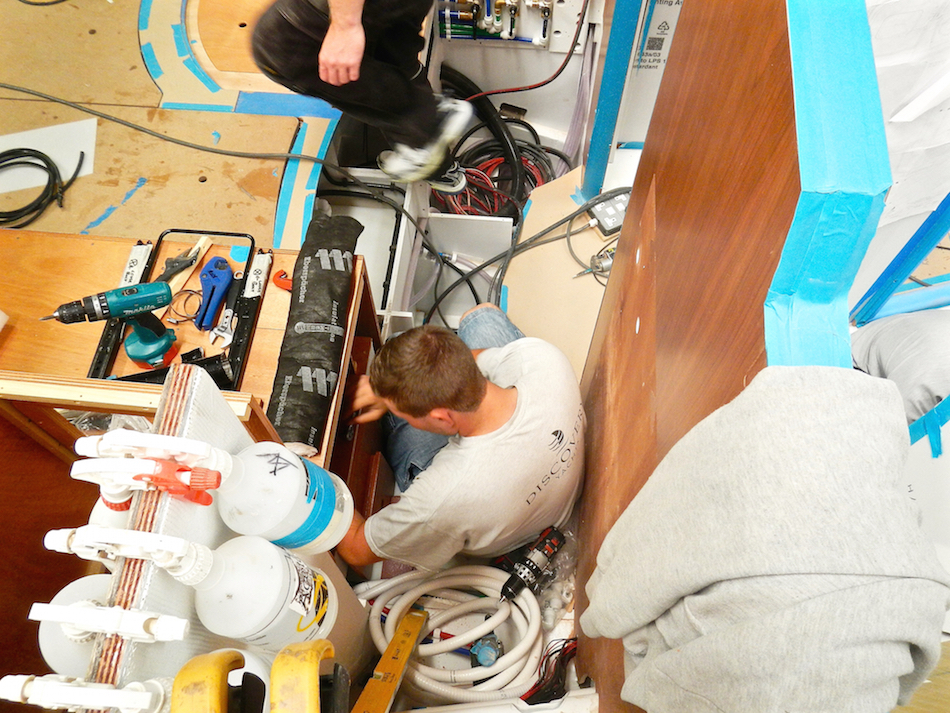

The woodworking area at Discovery. In the foreground, you see a few lockers, a settee and walls ready for the varnishing chamber.
Finally, we stepped onto a 55. It was almost at the end of it’s build process. What an elegant and above all, solid-looking boat! Sitting the deep centre cockpit, I thought, “this is a boat that makes you feel safe.” It was then I noticed the hot tub that we saw in the Discovery video. Yes, folks, there is a hot tub in the cockpit.
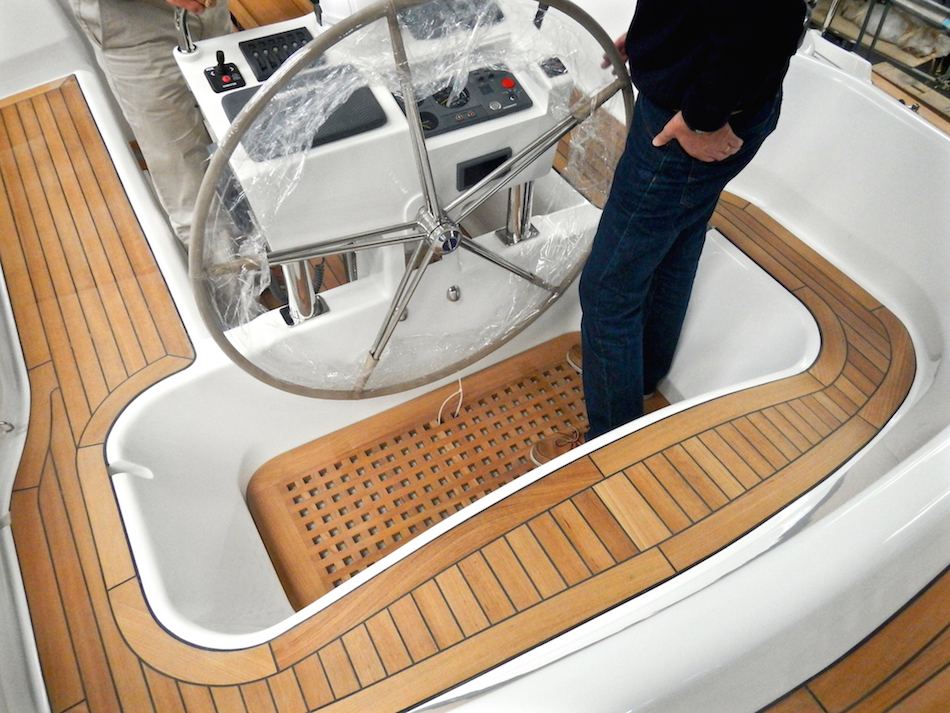
Jacques standing in the hot tub
For anyone who sails in the colder parts of the world, this is a serious plus. For us, Discovery racked up some serious bonus points with the hot tub. We imagined ourselves being in an anchorage in Norway in early spring, snow-blended rain coming down and sitting in our warm hot tub, glögg (nordic hot-mulled wine) in hand.

Here you see the hot, cold and salt water faucets for the hot tub
John and Caroline Charnley, the founders of Discovery and owners of hull number one, come up with this genius idea. It was simple. The helming position had been designed as a separate area from the rest of the cockpit, so it was just a matter of installing hot and cold water faucets to pour water into the area.
The companionway has only three wide and comfortable stairs to get into the saloon area. This was important as we have two large dogs. Too large to carry up and down the stairs. These stairs they could handle!
The nav station was just amazing with it’s 270° view. The nav station to us was always “sea sickness central” as it’s normally located deep down in the darkest part of the boat, with no view of what’s going on outside. The dinette also provides a 270° view. I started to daydream about being anchored up in a lovely anchorage in Sweden, reading a book or having a meal or drinks, and observing the beauty outside. We noticed that the windows in front open up to let a breeze through.
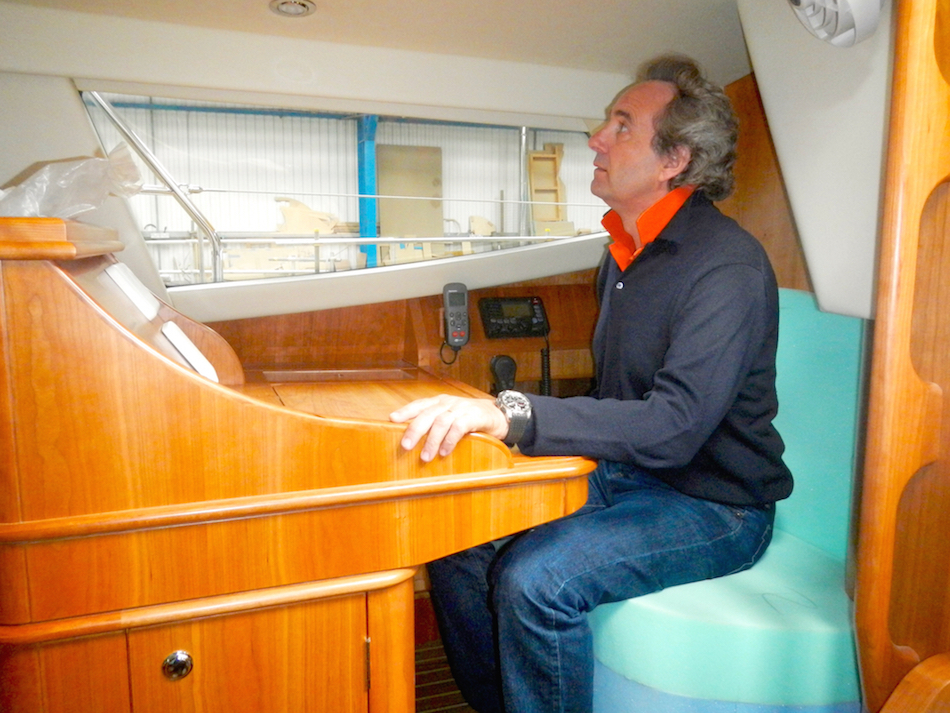
Jacques testing out the nav station
We were impressed with the galley. It had as many linear centimetres as our kitchen at home. The fridge and freezer had more capacity than ours at home. It also had one of those famous GN Espace 4-burner ovens. We had read about them in Yachting Monthly’s test of marine cookers, in which GN Espace won “Best on Test”.
To make a long story short, we were enchanted with the boat. Next, we sat down with all of our questions about the build process and materials used. And finally, we talked about an offer.
To our surprise, the boat came with a lot of standard items that are usually options on other boats, for example:
- Electric primary and control line winches
- Electric in-mast furling
- Solent rig or cutter rig with furling headsails
- Bow thruster
- Kevlar reinforced hull
- Folding Gori propeller
- 40 kg Delta anchor and 60 m of chain
- Bosch washer/dryer
- 7kW Victron generator
- Raymarine autopilot
- Raymarine chart-plotter
- Raymarine 4 kW radar
- 2 electric fresh-water toilets
- Eberspacher central heating
- Water-resistant leather seating for all seating
- 3 kW inverter/charger
- Pocket-sprung owners’ mattress
- Microwave oven
- Stereo systems with speakers inside and out
- Heavy-duty Sonnenschein deep-cycle batteries
- Victron Isolation transformer
- GN Espace 4-burner stove with oven
- Extractor fan over stove
- Lee cloths for all berths including in between the double berths
- Flush Lewmar hatches including mosquito and sun screens
- Icom VHF with DSC and masthead antenna
This was really great news because we knew just how much all of these items (or similar items) on this list cost. With one or two exceptions, they were all on the options list for the 3 other boats for which we had offers.
Here’s a list of the options we wanted and why at the outset:
- Extra hanging locker instead of desk/vanity in the owners’ cabin (closet space is always welcome, but a vanity?? I can fix my face in the heads, thank you, and we can use the navigation or dining table as a desk.)
- 55 kg Spade anchor and 100 meters of chain instead of the 40 kg Delta/60 meters (following the advice of John Harries on the excellent Attainable Adventure Cruising website, who wrote “two anchors don’t increase holding, holding is linear and heavier anchors set better.”)
- Hot tub plumbing (of course!)
- Full height pantry with sliding baskets instead of the wet locker (you always need lots of space for storing food).
- Fans in each cabin for ventilation
- Settee (sofa) instead of the standard pilot berth on starboard side (provides more floor space for the dogs and a place to sit down to put on your boots).
- Retaining catches on floor hatches (safety feature in case of capsize — see this video from Yachting Monthly magazine about what happens when you roll over.
- Bimini with full enclosure (a tent for the cockpit, something you see often in the colder climates so you can enjoy your cockpit when it rains or when it’s cold).
- Reckmann electric furlers (customer feedback and maintenance records at Discovery had shown they work pretty much flawlessly while the Furlex ones didn’t)
- Hydraulic boom vang (makes the topping lift superfluous – which means we’d have a “crane” to lift things from the water, such as the inflatable kayak we’ve been eying).
- Spinnaker halyard (this also serves as a “crane” for lifting things or a MOB from the water)
- Two additional mooring cleats aft and forward, giving us a total of 12 mooring cleats (would give us lots of margin for the “each line should have it’s own cleat” rule)
- Ribeye RIB and outboard (will be our Smart car whilst at anchor. This is a good model for people with dogs as the floor is flat and the dogs will be able to lie down.)
- Grey water tank (to fit in with new rules on water pollution/ecology in the Baltic Sea).
- Shoal keel draft of only 1.8 metres/5.9 feet (a shallow draft makes the Baltic Sea archipelago areas more accessible and it’s essential for some of my favourite anchorages in the Stockholm and St. Anna archipelagos in Sweden) instead of the standard 2.3 metres
This was the basis for the offer we requested from Discovery.
The last part of our day was a visit to Ocean Village Marina in downtown Southampton to see a 57 that was already in the water. We turned down an offer to test sail her. We thought that the 55 was so different from the 57, it wasn’t worth the extra day it would take.
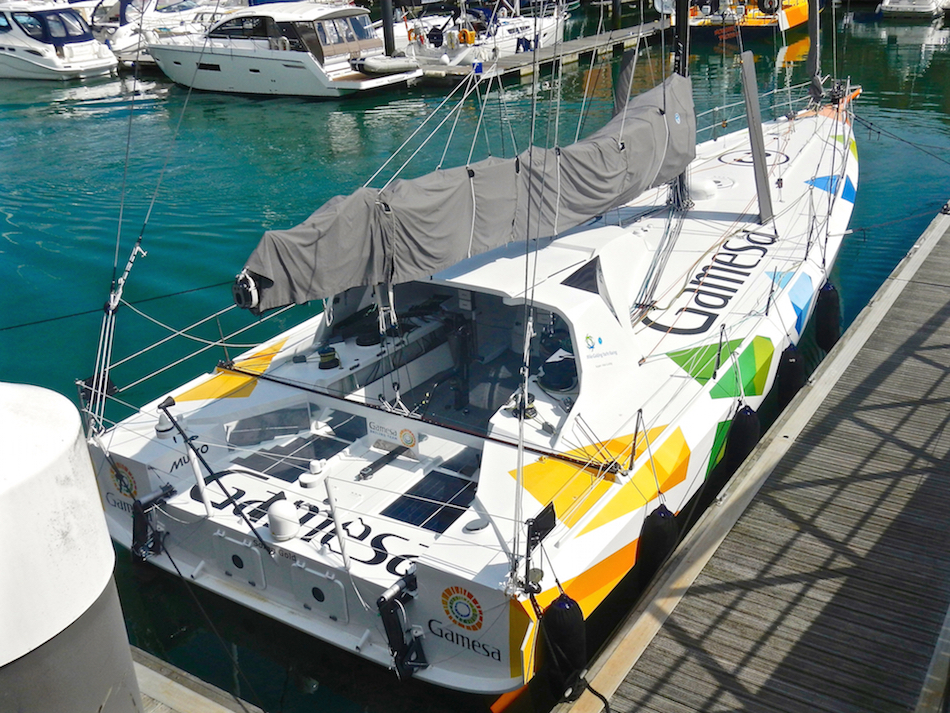
Mike Golding’s Open 60 “Gamesa” at Ocean Village Marina. He finished in 6th place in the Vendée Globe race (88 days, 6 hours).

The huge, twin-helm centre cockpit of the Discovery 57 – it felt much too big for us.
We had a chance to speak with John Charnley, the founder of Discovery Yachts. He was at Ocean Village getting his Discovery 50 catamaran ready for it’s next owner. We got an excellent impression of John. He seemed to be the quintessential British gentleman: soft-spoken, articulate and pleasant.
We now had a short list of three boats to consider. It was July, 2013 and we would have to make a final decision by October or November. We also had our appointment to visit the Hallberg Rassy yard at the end of August coming up.
“Dreaming about our future boat” was about to become “planning our future boat”.
